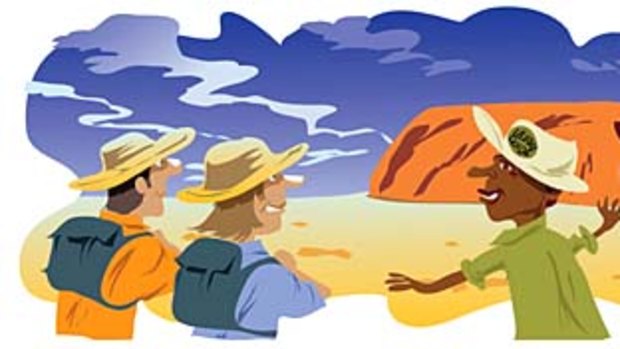By Jane E. Fraser

Illustration: Michael Mucci.
Outback authenticity adds to the Uluru experience but getting local, indigenous people involved has been an ongoing challenge.
FOR a place with so much indigenous significance, Ayers Rock Resort has for many years been surprising visitors with its lack of Aboriginal faces.
It is possible to spend several days at the resort without seeing a single indigenous person, despite this year marking 25 years since Uluru (Ayers Rock) and Kata Tjuta (The Olgas) were handed back to their traditional owners.
If a bold plan comes to fruition, this situation will change drastically over the next five years, with more than 200 indigenous people to be employed at the resort.
The Indigenous Land Corporation (ILC), which has bought the resort for $300 million, says in eight years' time the number will have climbed to 340 - more than half the resort's employees.
The indigenous-controlled statutory authority says from 2013 more than 200 people a year will be trained at a new indigenous tourism academy located next to the resort, ready to go into employment.
Yet many in the tourism industry are questioning where these trainees will come from and how successful the program will be.
The company that manages Ayers Rock Resort, Voyages, has tried hard to get indigenous employees on board and has all but failed. Other tourism operators have also found indigenous employment programs hard going, due to cultural differences and a limited number of people wanting to take part.
Will the ILC, working from the "inside", be able to succeed where others have failed?
A former chief executive of Voyages, Grant Hunt, says he wishes the ILC "good luck".
"It's a very commendable goal and I hope they can achieve what they aspire to achieve but the reality is that we tried very, very hard for many, many years with limited success," says Hunt, who has been a passionate supporter of indigenous programs.
Hunt says Voyages provided "unlimited" opportunities for training and employment but these were rarely taken up.
"The most we ever got in one intake was four [indigenous trainees]; only one was still working in hospitality five years later," he says.
Another champion of indigenous employment programs, David Baffsky, provided some insight into the challenges of such schemes during a speech at Bond University in Queensland two years ago.
Baffsky, an ILC board member and a former chairman of the Accor Asia Pacific hotel group, spoke of Accor's experience with its indigenous employment program, which has been running since 2001. "Despite the hundreds of indigenous employees we have introduced into our Accor scheme, we have had a disappointingly low retention rate," Baffsky says.
"We've had some success stories and many of our graduates have won awards and reached junior managerial levels but nowhere near enough."
Hunt says the most successful employment schemes tend to be those focused on the land, through farming, herding or conservation, and it is important to find jobs that are a good cultural fit.
"It [hospitality] is very, very foreign to them," he says. "[The Red Centre] is not the Aboriginal culture that people are seeing in Redfern [Sydney] or wherever; this is really authentic Aboriginal culture in the outback.
"We don't want to cajole Aboriginal people into doing something [that] they're not comfortable with." The general manager of the ILC, David Galvin, says the ILC will succeed where others have failed because indigenous employment is its core business, rather than a project by a commercial entity.
"We are not saying [that] it is going to be easy there, we know it is going to be incredibly difficult," Galvin says. "But we're not going to give up ... it will be a consistent and persistent effort."
Galvin says the ILC employed more than 130 indigenous people across 15 businesses last year and had another 200-plus in training programs. He expects indigenous people to come from all over Australia to take up training and employment programs at Ayers Rock Resort, the scale of which offers unprecedented opportunities.
However, Hunt questions the validity of bringing in "imports", saying his focus during his decade with Voyages had been about helping local communities, rather than
just getting indigenous people on the staff.
"You can import Aborigines from all over the place but what's the point?" he asks. "When I travel, I like to see authentic things. And it's only authentic if that Aboriginal person is from the local area."
Making a connection
EVEN inside the Uluru-Kata Tjuta National Park, it can be hard to connect with Aboriginal culture. The best option is the Aboriginal-owned Anangu Tours, which hosts tours including guided walks and dot painting workshops. The Cultural Centre, while run down, also provides some insight into Aboriginal culture, along with access to genuine Aboriginal art. The Sails in the Desert hotel within Ayers Rock Resort also has an artist-in-residence program, where visitors can chat with indigenous artists and watch them at work.
jane@janeefraser.com.au
Sign up for the Traveller Deals newsletter
Get exclusive travel deals delivered straight to your inbox. Sign up now.